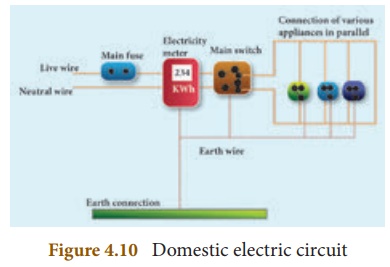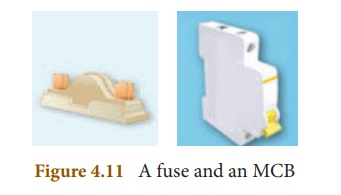Chapter: 10th Science : Chapter 4 : Electricity
Domestic Electric Circuits
DOMESTIC ELECTRIC
CIRCUITS
The electricity produced
in power stations is distributed to all the domestic and industrial consumers
through overhead and underground cables. The diagram, which shows the general
scheme of a domestic electric circuit, is given in Figure 4.10.
In our homes, electricity
is distributed through the domestic electric circuits wired by the
electricians. The first stage of the domestic circuit is to bring the power
supply to the main-box from a distribution panel, such as a transformer. The
important components of the main-box are: (i) a fuse box and (ii) a meter. The
meter is used to record the consumption of electrical energy. The fuse box
contains either a fuse wire or a miniature circuit breaker (MCB). The function
of the fuse wire or a MCB is to protect the house hold electrical appliances
from overloading due to excess current.

You have learnt about a
fuse wire in section 4.8.2. An MCB is a switching device, which can be
activated automatically as well as manually. It has a spring attached to the
switch, which is attracted by an electromagnet when an excess current passes
through the circuit. Hence, the circuit is broken and the protection of the
appliance is ensured. Figure 4.11 represents a fuse and an MCB.

The electricity is
brought to houses by two insulated wires. Out of these two wires, one wire has
a red insulation and is called the ŌĆślive wireŌĆÖ. The other wire has a black
insulation and is called the ŌĆśneutral wireŌĆÖ. The electricity supplied to your
house is actually an alternating current having an electric potential of 220 V.
Both, the live wire and the neutral wire enter into a box where the main fuse
is connected with the live wire. After the electricity meter, these wires enter
into the main switch, which is used to discontinue the electricity supply
whenever required. After the main switch, these wires are connected to live
wires of two separate circuits. Out of these two circuits, one circuit is of a
5 A rating, which is used to run the electric appliances with a lower power rating,
such as tube lights, bulbs and fans. The other circuit is of a 15 A rating,
which is used to run electric appliances with a high power rating, such as
air-conditioners, refrigerators, electric iron and heaters. It should be noted
that all the circuits in a house are connected in parallel, so that the
disconnection of one circuit does not affect the other circuit. One more
advantage of the parallel connection of circuits is that each electric
appliance gets an equal voltage.
1. Overloading and Short circuiting
The fuse wire or MCB
will disconnect the circuit in the event of an overloading and short
circuiting. Over loading happens when a large number of appliances are
connected in series to the same source of electric power. This leads to a flow
of excess current in the electric circuit.
When the amount of
current passing through a wire exceeds the maximum permissible limit, the wires
get heated to such an extent that a fire may be caused. This is known as
overloading. When a live wire comes in contact with a neutral wire, it causes a
ŌĆśshort circuitŌĆÖ. This happens when the insulation of the wires get damaged due
to temperature changes or some external force. Due to a short circuit, the
effective resistance in the circuit becomes very small, which leads to the flow
of a large current through the wires. This results in heating of wires to such
an extent that a fire may be caused in the building.
2. Earthing
In domestic circuits, a
third wire called the earth wire having a green insulation is usually connected
to the body of the metallic electric appliance. The other end of the earth wire
is connected to a metal tube or a metal electrode, which is buried into the
Earth. This wire provides a low resistance path to the electric current. The
earth wire sends the current from the body of the appliance to the Earth,
whenever a live wire accidentally touches the body of the metallic electric
appliance. Thus, the earth wire serves as a protective conductor, which saves
us from electric shocks.
Related Topics